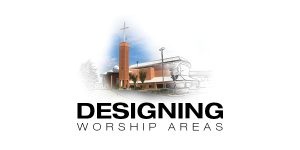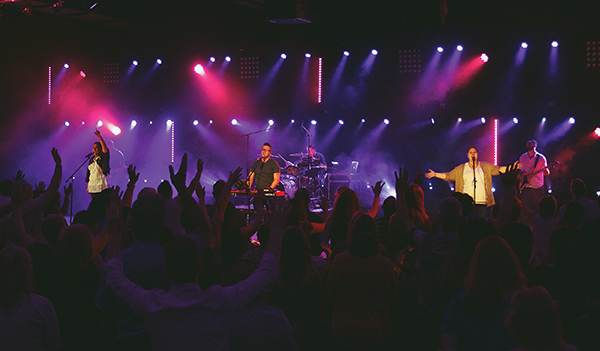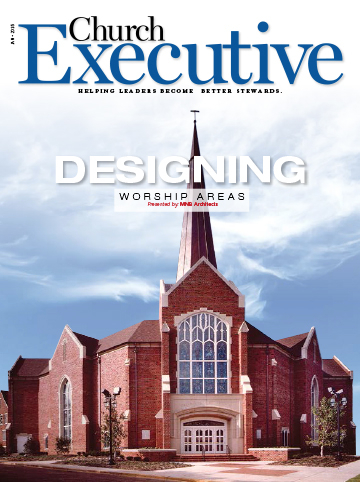
By Curtiss H. Doss, AIA with Doug Hood
 Acoustical, audio, video and lighting systems can drastically influence — positively and / or negatively — the entire built environment of a worship space.
Acoustical, audio, video and lighting systems can drastically influence — positively and / or negatively — the entire built environment of a worship space.
Regardless of the type, size, style and so on, these systems today are much like the story of an old minister of music colleague: No one would ever allow a pianist to consistently miss notes while playing for worship.
The same is true for the technical staff and the equipment used.
Acoustical, audio, video and lighting systems are becoming more and more prevalent in the worship environment as a way of engaging the worshiper more than just through the auditory system. God has uniquely made each of us in such a way that, as our senses are stimulated, we gain more understanding. The more senses that are simultaneously stimulated, the more understanding is possible —and the more memorable the experience.
(Wow! We were fearfully and wonderfully made.)
Focus on: acoustics
While somewhat hard to understand, proper acoustical environments are critical to a successful room. While it’s possible to take a room that’s acoustically incorrect and install an audio system, the system will be less than its best until the acoustical system is correct. It’s like saying the transmission (audio system) is working great, while the engine (acoustical system) isn’t firing correctly on two cylinders. The car will go down the road, but those cylinders that aren’t firing will directly correlate to the difficulty attaining adequate intelligibility with the audio system. So, make sure the acoustics are good before spending tons of money on an audio system.
 Focus on: audio
Focus on: audio
Audio systems — commonly referred to as sound systems, but more aptly named sound reinforcement systems — have become as common as a keyboard to the worship space environment.
Regardless of denomination or worship style, all church leaders can agree that the delivery of the spoken word (specifically, the gospel message) is of the utmost importance. Let me go one step further: The clarity of the spoken word and the ability for the congregation to understand it must be the highest priority. In other words, it’s one thing for the pastor to present the Word; it’s a far different thing to evaluate if the congregation can clearly hear every word and understand the message. If your church is contemplating a new sound system — whether for a renovation or a new construction project — take comfort in knowing that there’s a way to predict and measure this type of clarity of a loudspeaker system. It’s called a Speech Transmission Index, or STI, and it can be calculated within acoustical design software. The STI score of a system ranges from 0 to 1. The higher the STI score, the better the intelligibility. An STI rating of 0 would be the worst, while a score of 1 would be the best. It’s too much detail to get into here, but when a church works with a reputable firm who specializes in these systems, it can get a prediction of how well its system will perform during the design stage. The church can also measure and test the final results when the system installation is complete.
Focus on: video
Almost as common are video systems, which typically are used for projection of a computer-generated image for better visibility to the seating areas. These same systems can be used for image magnification via a video camera input and some complex graphic components. All these systems are typically used to draw worshippers into the worship experience by touching more of their individual senses.

The world of video is light years beyond just a screen and a projector. Not too long ago, the era of slide projectors and overhead projectors was in effect. After that came the magic of the LCD projector, which put vastly increased brightness within most churches’ reach. These projectors were pretty simple to use, and you could feed a computer or camera signal into it. Oh, the excitement!
Today, a proper video system design takes much more into account than just the size of the screen and the brightness of the projector. Just the screen itself can be a topic of discussion. Will you use left / right screens, or left / center / right, or triple-wide? Each has its own merits, which are important to evaluate during the design phase.
Next, your church will need to decide on a projector type, such as LCD, DLP or laser. Which will be best-suited to your needs and budget? Beyond projectors, there are applications where it’s best to use a single LED TV, or a group of LED TVs in a custom video wall configuration. For venues with tons of natural light pouring through — and also churches looking to be more creative with their displays — an approach using LED modular video walls can be the best solution. LED walls are totally scalable, which is a very attractive attribute when designing a custom size to fit a custom space. Beyond the obvious, there are also applications for additional video systems to serve as a digital chalkboard for the pastor, as well as “fill” monitors for use as more of a visual design element than just for lyrics or sermon notes.
The only limit is your imagination.
Also important is to study not just how the congregation views video content, but how the people on the stage can view it. Most churches are using some type of presentation software that allows them to display song lyrics to the congregation. But, how do the singers onstage see the lyrics?Depending on the depth of the room, large projection screens, TVs or LED walls can be placed on the back wall. This is sometimes referred to as a video “confidence monitor.” If the room has a balcony, this limits placement options; so, the confidence monitor could be placed on the balcony face, or there are some instances when TVs are positioned in front of the stage. As you review placement options, one thing to keep in mind is to imagine how the people on stage will appear as they look up or down to their confidence monitor. As others (the pastor, worship team and so on) lead the congregation, the goal is for the people on stage to appear as if they’re looking at the congregation; we don’t want them looking down at the floor or up at the ceiling.
Video plays a huge role outside the worship space, too. For example, how is video information transferred across the facility? Commonly referred to as “digital signage,” these systems are very effective in creating interest throughout the space, communicating content such as announcements / directions, and also for projecting a live camera feed to places such as the nursery, green room, etc., so those outside the worship space are connected to what’s happening, in real time.
Focus on: lighting
The introduction of lighting systems was very long ago; however, the advent of new technology and the need for better visual acuity has translated a somewhat straightforward lighting concept to one which can completely transition a plain environment into a very special place.
For years now, all CSD’s designs have used all-LED solutions. That means no bulbs to change, and also no dimmer racks. This represents huge energy savings for existing buildings and new construction projects alike. When planning for your new system, you’ll want to look for a mix of fixture types. Variety is important. You want to have many tools in your toolbox so you can be creative — not just now, but for years to come as you continually work on new stage designs.
A typical system will use a combination of ellipsoidals (spots), fresnel / PAR (floods), moving lights, and strip lights for architectural accent / wall wash. By using a variety of fixtures, you’ll not only gain flexibility for design, but also save money as you can incorporate different budget ranges of fixtures. Keep in mind in this new world of LED fixtures that these can potentially require a lot of DMX channels. Be mindful during the design phase to track the amount of DMX channels required for your system, and take that into account before choosing your lighting control system.
Now, let’s move on to the house lighting fixtures for your space. The cost of full-color mixing RGBW LED fixtures has continued to come down as more and more manufacturers have created viable options. As the name implies, each fixture has red, green, blue and white LEDs so they’re capable of creating excellent white light for your day-to-day use, or for use during the sermon. However, they can also create any color of the rainbow, so you can transform the entire room instantly and creatively for worship, concerts, dramas and special productions. Currently, this is one of the areas I see clients get most excited about. Imagine your entire worship center as your empty canvas and you have a full box of huge Crayons; the possibilities are endless. Not all people respond to “production,” but everyone responds to beauty. A creative, custom lighting system will give you the ability to literally bathe your worship space in a beautiful array of color.
Examining environmental projection
Many churches have the need to dramatically change the look of the sanctuary, but quickly and without a bunch of stuff to move around or storage concerns. Environmental projection (EP) is a tremendous value and makes this possible.
EP goes over and above the “regular” video projection system; it uses several projectors (typically, three) designed to use the walls / ceiling as the projection surface instead of a projection screen. Many churches need to do a traditional service and a contemporary service in the same space — but how? How can you create an atmosphere that will appeal to both groups of people, each different in their expectations? EP allows you to create a visually immersive space.
Let’s say you have a traditional service at 9 a.m. With EP, for your 9 a.m. service, you could project stained glass across the entire width of the room. Or, you could simply leave the system turned off — whatever works best for your congregation. Then, for your 11 a.m. contemporary service, you could have something beautiful, something edgy, or something crazy. The key to the effectiveness of this system is using what works best for your group.
Each church is different. As you tap into what your congregation responds best to, you’ll see what a powerful and creative tool environmental projection can be.
Blur the line
When it gets really cool is when the blending of all these systems — properly designed and integrated — begin to create a synergistic function of pushing the worship experience, both music and spoken word, into an entirely new realm of capacity. It’s like moving from a flat-bottom fishing boat with paddle to a bass boat with a high-speed motor.
The worlds of audio / video / lighting are colliding — and that’s a good thing! As mentioned previously, there are video pieces that used as design elements. There are lighting pieces that project images. There are motorized fixtures with projectors inside so you can project full-motion video anywhere you want it. There are electronic systems that allow us to alter the acoustics of the room from an iPad. You can see how the various aspects of technology are morphing into one. This is awesome when designing!
We can now approach your entire room as a canvas, not just the stage. Often, I talk about the invisible line that exists between the front edge of the stage and the rest of the room. My goal is to remove that line altogether, or at least blur it. Working with a team approach (architect, A/V/L/A firm, builder), we encourage you to blur that line through creative design, focused engineering, and a huge vision to make your space the best it can be to deliver the most powerful Message in the world.
The bottom line is this: you need a great design team of folks — architects, engineers and specialty consultants — to create the best environments for the most effective worship experiences. They don’t have to be expensive in a relative discussion, but they do need to be balanced and done well.
One last time: Each church has a different DNA and must be addressed separately than any other church. Cookie-cutter solutions are for cookies — not churches!
Curtiss H. Doss, AIA is principal of McGehee Nicholson Burke (MNB) Architects in Memphis, TN. Doss has consulted with church clients for more than 20 years, and his architectural practice spans more than 30 years.
Doug Hood is president of CSD Group, Inc. (audio / video / lighting / acoustics) in Fort Wayne, IN, and an NACDB-Certified Church Consultant.


